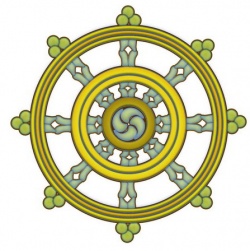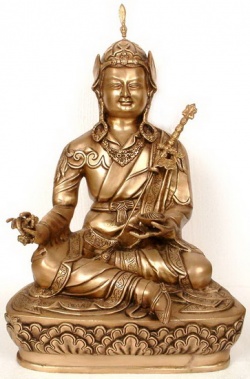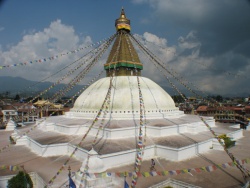Uncompromising Idealism or the School of Vijnanavada Buddhism
The school of Buddhist philosophy known as the Vijnanavada or Yogacara has often been referred to by such prominent teachers of Hindu thought as Kumarila and S'a@nkara. It agrees to a great extent with the S'unyavadins whom we have already described. All the dharmas (qualities and substances) are but imaginary constructions of ignorant minds. There is no movement in the so-called external world as we suppose, for it does not exist. We construct it ourselves and then are ourselves deluded that it exists by itself (_nirmmitapratimohi_) [Footnote ref 229]. There are two functions involved in our consciousness, viz. that which holds the perceptions (_khyati vijnana_), and that which orders them by imaginary constructions (_vastuprativikalpavijnana_). The two functions however mutually determine each other and cannot be separately distinguished (_abhinnalak@sa@ne anyonyahetuke_). These functions are set to work on account of the beginningless instinctive tendencies inherent in them in relation to the world of appearance (_anadikala-prapanca-vasanahetukanca_) [Footnote ref 230].
All sense knowledge can be stopped only when the diverseunmanifested instincts of imagination are stopped (_abhuta-parikalpa-vasana-vaicitra-nirodha_) [Footnote ref 231]. All our phenomenal knowledge is without any essence or truth (_nihsvabhava_) and is but a creation of maya, a mirage or a dream. There is nothing which may be called external, but all is the imaginary creation of the mind (_svacitta_), which has been accustomed to create imaginary appearances from beginningless time. This mind by whose movement these creations take place as subject and object has no appearance in itself and is thus without any origination, existence and extinction (_utpadasthitibha@ngavarjjam_) and is called the alayavijnana. The reason why this alayavijnana itself is said to be without origination, existence, and extinction is probably this, that it is always a hypothetical state which merely explains all the phenomenal states that appear, and therefore it has no existence in the sense in which the term is used and we could not affirm any special essence of it.
We do not realize that all visible phenomena are of nothing external but of our own mind (_svacitta_), and there is also the beginningless tendency for believing and creating a phenomenal world of appearance. There is also the nature of knowledge (which takes things as the perceiver and the perceived) and there is also the instinct in the mind to experience diverse forms. On account of these four reasons there are produced in the alayavijnana (mind) the ripples of our sense experiences (_prav@rttivijnana_) as in a lake, and these are manifested as sense experiences. All the five skandhas called _panchavijnanakaya_ thus appear in a proper synthetic form. None of the phenomenal knowledge that appears is either identical or different from the alayavijnana just as the waves cannot be said to be either identical or different from the ocean. As the ocean dances on in waves so the citta or the alayavijnana is also dancing as it were in its diverse operations (_v@rtti_). As citta it collects all movements (_karma_) within it, as manas it synthesizes (_vidhiyate_) and as vijnana it constructs the fivefold perceptions (_vijnanan vijanati d@rs'yam kalpate pancabhi@h_) [Footnote ref 232].
It is only due to maya (illusion) that the phenomena appear in their twofold aspect as subject and object. This must always be regarded as an appearance (_samv@rtisatyata_) whereas in the real aspect we could never say whether they existed (_bhava_) or did not exist [Footnote ref 233].
All phenomena both being and non-being are illusory (_sadasanta@h mayopama@h_). When we look deeply into them we find that there is an absolute negation of all appearances, including even all negations, for they are also appearances. This would make the ultimate truth positive. But this is not so, for it is that in which the positive and negative are one and the same (_bhavabhavasamanata_) [Footnote ref 234]. Such a state which is complete in itself and has no name and no substance had been described in the La@nkavatarasutra as thatness (_tathata_) [Footnote ref 235]. This state is also described in another place in the _La@nkavatara_ as voidness (_s'unyata_) which is one and has no origination and no essence [Footnote ref 236]. In another place it is also designated as tathagatagarbha [Footnote ref 237].
It may be supposed that this doctrine of an unqualified ultimate truth comes near to the Vedantic atman or Brahman like the tathata doctrine of As'vagho@sa; and we find in La@nkavatara that Rava@na asks the Buddha "How can you say that your doctrine of tathagatagarbha was not the same as the atman doctrine of the other schools of philosophers, for those heretics also consider the atman as eternal, agent, unqualified, all pervading and unchanged?" To this the Buddha is found to reply thus--"Our doctrine is not the same as the doctrine of those heretics; it is in consideration of the fact that the instruction of a philosophy which considered that there was no soul or substance in anything (nairatmya) would frighten the disciples, that I say that all things are in reality the tathagatagarbha. This should not be regarded as atman. Just as a lump of clay is made into various shapes, so it is the non-essential nature of all phenomena and their freedom from all characteristics (_sarvavikalpalak@sa@navinivrttam_) that is variously described as the garbha or the nairatmya (essencelessness). This explanation of tathagatagarbha as the ultimate truth and reality is given in order to attract to our creed those heretics who are superstitiously inclined to believe in the atman doctrine [Footnote ref 238]."
So far as the appearance of the phenomena was concerned, the idealistic Buddhists (_vijnanavadins_) agreed to the doctrine of pratityasamutpada with certain modifications. There was with them an external pratityasamutpada just as it appeared in theobjective aspect and an internal pratityasamutpada. The external pratityasamutpada (dependent origination) is represented in the way in which material things (e.g. a jug) came into being by the co-operation of diverse elements--the lump of clay, the potter, the wheel, etc. The internal (_adhyatmika_) pratityasamutpada was represented by avidya, t@r@s@na, karma, the skandhas, and the ayatanas produced out of them [Footnote ref 239].
Our understanding is composed of two categories called the _pravichayabuddhi_ and the _vikalpalak@sa@nagrahabhinives'aprati@s@thapikabuddhi_. The pravicayabuddhi is that which always seeks to take things in either of the following four ways, that they are either this or the other (_ekatvanyaiva_); either both or not both (_ubhayanubhaya_), either are or are not (_astinasti_), either eternal or non-eternal (_nityanitya_). But in reality none of these can be affirmed of the phenomena. The second category consists of that habit of the mind by virtue of which it constructs diversities and arranges them (created in their turn by its own constructive activity--_parikalpa_) in a logical order of diverse relations of subject and predicate, causal and other relations. He who knows the nature of these two categories of the mind knows that there is no external world of matter and that they are all experienced only in the mind. There is no water, but it is the sense construction of smoothness (_sneha_) that constructs the water as an external substance; it is the sense construction of activity or energy that constructs the external substance of fire; it is the sense construction of movement that constructs the external substance of air. In this way through the false habit of taking the unreal as the real (_mithyasatyabhinives'a_) five skandhas appear. If these were to appear all together, we could not speak of any kind of causal relations, and if they appeared in succession there could be no connection between them, as there is nothing to bind them together. In reality there is nothing which is produced or destroyed, it is only our constructive imagination that builds up things as perceived with all their relations, and ourselves as perceivers. It is simply a convention (_vyavahara_) to speak of things as known [Footnote ref 240]. Whatever we designate by speech is mere speech-construction (_vagvikalpa_) and unreal. In speech one could not speak of anything without relating things in some kind of causalrelation, but none of these characters may be said to be true; the real truth (_paramartha_) can never be referred to by such speech-construction.
The nothingness (_s'unyata_) of things may be viewed from seven aspects--(1) that they are always interdependent, and hence have no special characteristics by themselves, and as they cannot be determined in themselves they cannot be determined in terms of others, for, their own nature being undetermined, a reference to an "other" is also undetermined, and hence they are all indefinable (_laksanas'unyata_); (2) that they have no positive essence (_bhavasvabhavas'unyata_), since they spring up from a natural non-existence (_svabhavabhavotpatti_); (3) that they are of an unknown type of non-existence (_apracaritas'unyata_), since all the skandhas vanish in the nirvana; (4) that they appear phenomenally as connected though non-existent (_pracaritas'unyata_), for their skandhas have no reality in themselves nor are they related to others, but yet they appear to be somehow causally connected; (5) that none of the things can be described as having any definite nature, they are all undemonstrable by language (_nirabhilapyas'unyata_);
(6) that there cannot be any knowledge about them except that which is brought about by the long-standing defects of desires which pollute all our vision; (7) that things are also non-existent in the sense that we affirm them to be in a particular place and time in which they are not (_itaretaras'unyata_).
There is thus only non-existence, which again is neither eternal nor destructible, and the world is but a dream and a maya; the two kinds of negation (_nirodha_) are akas'a (space) and nirvana; things which are neither existent nor non-existent are only imagined to be existent by fools.
This view apparently comes into conflict with the doctrine of this school, that the reality is called the tathagatagarbha (the womb of all that is merged in thatness) and all the phenomenal appearances of the clusters (_skandhas_), elements (_dhatus_), and fields of sense operation (_ayatanas_) only serve to veil it with impurities, and this would bring it nearer to the assumption of a universal soul as the reality. But the _La@nkavatara_ attempts to explain away this conflict by suggesting that the reference to the tathagatagarbha as the reality is only a sort of false bait to attract those who are afraid of listening to the nairatmya (non-soul doctrine) [Footnote ref 241].
The Bodhisattvas may attain their highest by the fourfold knowledge of
(1) _svacittad@rs'hyabhavana_,
(2) _utpadasthitibha@ngavivarjjanata_,
(3) _bahyabhavabhavopalak@sa@nata_ and
(4) _svapratyaryyajnanadhigamabhinnalak@sa@nata_.
The first means that all things are but creations of the imagination of one's mind. The second means that as things have no essence there is no origination, existence or destruction. The third means that one should know the distinctive sense in which all external things are said either to be existent or non-existent, for their existence is merely like the mirage which is produced by the beginningless desire (_vasana_) of creating and perceiving the manifold. This brings us to the fourth one, which means the right comprehension of the nature of all things.
The four dhyanas spoken of in the _Lankavatara_ seem to be different from those which have been described in connection with the Theravada Buddhism. These dhyanas are called
(1) _balopacarika_,
(2) _arthapravichaya_,
(3) _tathatalambana_ and
(4) _tathagata_.
The first one is said to be that practised by the s'ravakas and the pratyekabuddhas. It consists in concentrating upon the doctrine that there is no soul (_pudgalanairatmya_), and that everything is transitory, miserable and impure. When considering all things in this way from beginning to end the sage advances on till all conceptual knowing ceases (_asa@mjnanirodhat_); we have what is called the valopacarika dhyana (the meditation for beginners).
The second is the advanced state where not only there is full consciousness that there is no self, but there is also the comprehension that neither these nor the doctrines of other heretics may be said to exist, and that there is none of the dharmas that appears. This is called the _arthapravicayadhyana_, for the sage concentrates here on the subject of thoroughly seeking out (_pravichaya_) the nature of all things (_artha_).
The third dhyana, that in which the mind realizes that the thought that there is no self nor that there are the appearances, is itself the result of imagination and thus lapses into the thatness (_tathata_). This dhyana is called _tathatalambana_, because it has for its object tathata or thatness.
The last or the fourth dhyana is that in which the lapse of the mind into the state of thatness is such that the nothingness and incomprehensibility of all phenomena is perfectly realized; and nirvana is that in which all root desires (_vasana_) manifesting themselves in knowledge are destroyed and the mind with knowledge and perceptions, making false creations, ceases to work. This cannot be called death, for it will not have any rebirth and it cannot be called destruction, for only compounded things (_sa@msk@rta_) suffer destruction, so that it is different from either death or destruction. This nirvana is different from that of the s'ravakas and the pratyekabuddhas for they are satisfied to call that state nirva@na, in which by the knowledge of the general characteristics of all things (transitoriness and misery) they are not attached to things and cease to make erroneous judgments [Footnote ref 242].
Thus we see that there is no cause (in the sense of ground) of all these phenomena as other heretics maintain. When it is said that the world is maya or illusion, what is meant to be emphasized is this, that there is no cause, no ground. The phenomena that seem to originate, stay, and be destroyed are mere constructions of tainted imagination, and the tathata or thatness is nothing but the turning away of this constructive activity or nature of the imagination (_vikalpa_) tainted with the associations of beginningless root desires (_vasana_) [Footnote ref 243]. The tathata has no separate reality from illusion, but it is illusion itself when the course of the construction of illusion has ceased. It is therefore also spoken of as that which is cut off or detached from the mind (_cittavimukta_), for here there is no construction of imagination (_sarvakalpanavirahitam_) [Footnote ref 244].





